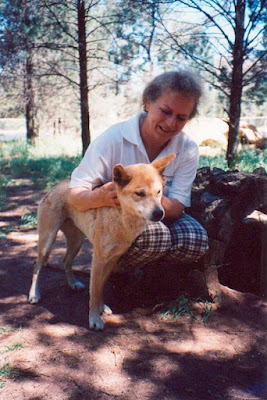 |
| The final design - Copyright Australia Post - used with permission. |
Berenice would often go to bed depressed and frustrated about what to do next to further the cause and wake in the morning with a bolt of inspiration.
She received a reply to her enquiry within a few days advising her that an issue of stamps titled 'Dogs of Australia' was planned for release in early 1980. The letter advised that as the release was to be in two years the information was to be kept confidential. It also requested a photo be submitted.
The stamps featured the Dingo, Australian Cattle Dog, Australian Kelpie, Border Collie and Australian Terrier. Original photographs were accepted for the design. The photo submitted by Berenice depicted Snowgoose, as an adult Alpine bitch. A separate photo of Napilia, Napoleon’s daughter, a tropical pup, was added to the design.

Photo of Snowgoose submitted for the stamp design
When the stamp was released one newspaper ran the headline: 20c BOUNTY POSTED ON THE DINGO.
Berenice was heartened a further sign of a change in attitude towards the Dingo was imminent when the image was chosen for the prestigious 20c stamp. 20c was the cost of a standard letter, making it the most common of the stamps in circulation.
She believed “the inclusion of the Dingo, the dog of the original inhabitants of Australia, would be hailed the world over as a decisive step forward in the annals of appreciation of that which belongs to us all, our national heritage”.
Ironically, at the time, the Dingo was still regarded as vermin by all state and territory governments and still had a bounty on its head in Victoria.
The inclusion of the Dingo stamp in the “Dogs of Australia” set drew enthusiastic acclaim from overseas.
In a letter from the USA, Dr E Klinghammer of the North American Wildlife Park Foundation wrote: “What a victory to have the Dingo on a stamp at last. It is beautiful. People in this country have been working on a wolf stamp, but so far without success. I am sure that gave you a great boost, and I hope that the people in your country will do all they can to accept the Dingo on his own terms….”
***
 Snowgoose’s story is told in the book For the Love of a Dingo by Berenice Walters and Pamela King.
Available through the website www.pam.id.au
Snowgoose’s story is told in the book For the Love of a Dingo by Berenice Walters and Pamela King.
Available through the website www.pam.id.au







